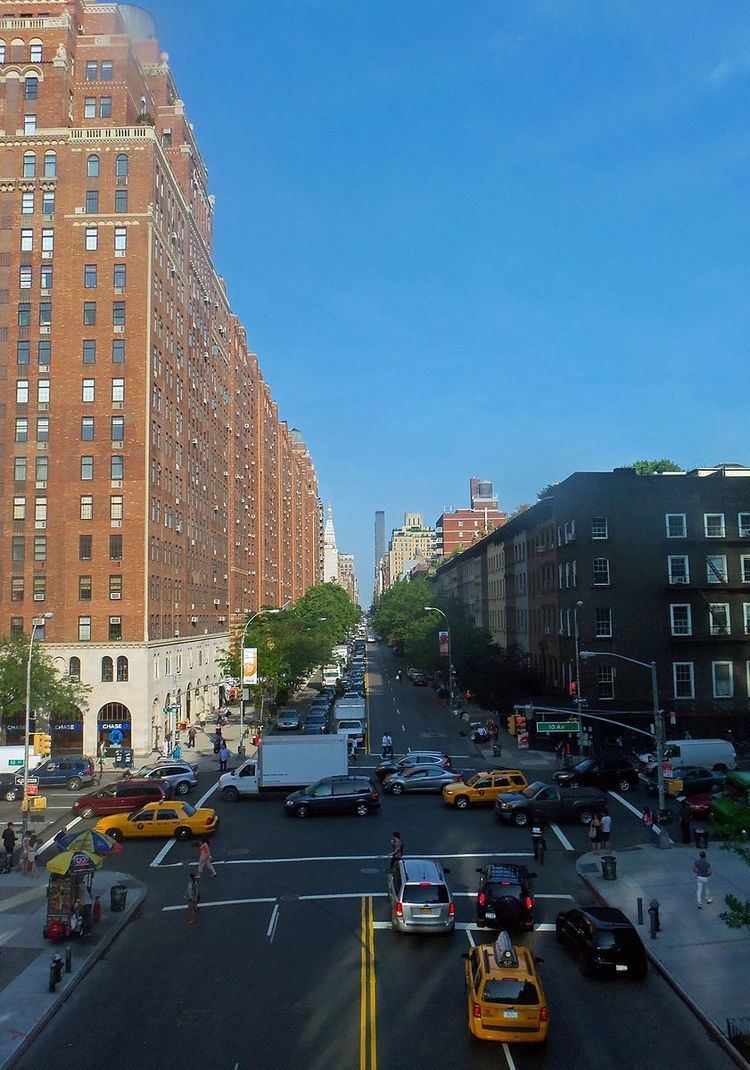Maintained by NYCDOT Postal code 10011, 10010 | Length 1.9 mi (3.1 km) Commissioned March 1811 | |
 | ||
Similar | ||
23rd Street is a broad thoroughfare in the New York City borough of Manhattan, one of the major two-way, east-west streets in the borough's grid. As with Manhattan's other "crosstown" streets, it is divided at Fifth Avenue, in this case at Madison Square Park, into its east and west sections. Since 1999 the area north of 23rd Street around the park has been referred to as Nomad. The street formerly ran from the East River to the Hudson River, but now terminates at 11th Avenue.
Contents
History
The street was designated by the Commissioners' Plan of 1811 that established the Manhattan street grid as one of 15 east-west streets that would be 100 feet (30 m) in width (while other streets were designated as 60 feet (18 m) in width).
West 23rd Street
West 23rd carves through the heart of Chelsea. For much of the late 19th century and early 20th century its western end was site of the Pavonia Ferry at Pier 63, just north of the Chelsea Piers. London Terrace is slight farther inland. In the late 19th century, the western part of 23rd Street was to American theater what Broadway is today, with the Opera House Palace and Pike's Opera House one block away and Proctor's Theater ("continuous daily vaudeville") across the street from the Hotel Chelsea. 23rd Street remained New York's main theater strip until The Empire opened on Broadway some twenty blocks uptown, ushering in a new era of theater.
The Hotel Chelsea, New York's first co-op apartment complex, was built here in 1883; it was New York's tallest building until 1902. Sid Vicious and Nancy Spungen lived in the Hotel Chelsea from August 1978. Spungen was stabbed to death in the bathroom of her room at the Hotel Chelsea in October 1978.
The block of 23rd Street between Fifth and Sixth Avenues is part of the Ladies' Mile Historic District.
East 23rd Street
East 23rd Street, which runs between Fifth Avenue and the East River (FDR Drive), is a main street of Manhattan's neighborhood of Gramercy Park. The Metropolitan Life Insurance Company (MetLife), headquartered at 1 Madison Avenue at East 23rd Street, played a significant role in shaping the character of development along East 23rd Street in the early 20th century.
Opposite Madison Square Park on East 23rd Street are two skyscrapers originally built by MetLife. 1 Madison Avenue, with its ornate clocktower face, was one of Manhattan's first skyscrapers. 11 Madison Avenue was intended to be the base of a much taller skyscraper, but the onset of the Depression forced MetLife to scale back its plans. Even so, the building stands today as an Art Deco masterpiece.
Peter Cooper Village, one of MetLife's experiments in middle-income community building (until bought by Tishman Speyer). Peter Cooper Village was a sister project to MetLife's Stuyvesant Town, which was built across 20th Street to the south.
On the far east end of East 23rd are Stuyvesant Cove Park, the Asser Levy Public Baths, and a parking garage now used as a gas station.
On October 17, 1966, this street was also witness to New York's deadliest fire in terms of firefighters killed until the September 11 attacks. The "23rd Street Fire", as it came to be called, began in a cellar at 7 East 22nd Street and soon spread to the basement of 6 East 23rd Street, a five-story commercial building that housed a drugstore at street level. Twelve firefighters were killed; two chiefs, two lieutenants, and six firefighters plunged into the flaming cellar, while two more firefighters were killed by the blast of flame and heat on the first floor.
The Flatiron Building is on the south side of the street at Broadway. The origin of the term "23 skidoo" is said to be from wind gusts caused by the building's triangular shape or hot air from a shaft through which immense volumes of air escaped, producing gusts that supposedly lifted women's skirts.
Public transit
Every New York City Subway line that crosses 23rd Street has a local station there:
Port Authority Trans-Hudson has a station at 23rd Street as well.
In the past, every former IRT elevated line had a station at 23rd Street, most of which were local stations:
Additionally, MTA New York City Transit's M23 bus runs the length of 23rd Street. This replaced the horse-drawn and later electric-powered Twenty-Third Street Railway. In 2003, the Straphangers Campaign listed the M23 as one of the slowest in the city, winning its "Pokey Award."
